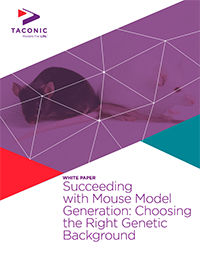Transgenesis is the introduction of an exogenous DNA sequence into the genome of an organism, usually with the goal to drive protein expression in a specific spacial or temporal way. Transgenes can be introduced into the genome in either a random or targeted manner.
Random integration transgenesis uses pronuclear injection (PNI) and can be achieved in mice and rats. The DNA construct is microinjected into the pronucleus of a zygote during its single-cell phase; then the zygote is implanted in a pseudopregnant foster female mouse or rat and on average, 10-20% of the resulting offspring carry the transgene. While the DNA construct often is derived from a plasmid, larger cloning vectors can also be used, including bacterial artificial chromosomes (BACs). The larger capacity (up to 200 kb) of BAC vectors is often advantageous because it can allow the inclusion of sizeable (>50 kb) genomic regions both up- and downstream from the gene of interest.

Model generation through random integration transgenesis is a favored path to rapidly generate models that express an ectopic gene and pass the trait onto their offspring. Random transgenesis is suitable for a variety of applications, including expression of a humanized protein in the mouse or rat, research on diseases resulting from copy number variations (e.g., autism and other complex neurological diseases) and those involving gene overexpression (e.g., certain forms of breast cancer). This approach also can be employed to label a specific cell type or to tag a gene with a reporter for the study of a gene’s expression pattern. Similarly, Cre recombinase can be expressed in a tissue-specific fashion to allow conditional knockout or knock-in models.

Random integration transgenesis is often thought of as the simplest way to genetically modify an organism, and generating founder mice and rats containing a transgene can be accomplished on a timeline of approximately 12-20 weeks, making it a faster alternative to more targeted approaches like gene targeting in embryonic stem (ES) cells. It is also applicable to mouse and rat models with a wide range of genetic backgrounds, making it somewhat more versatile than gene targeting. However, because genomic integration site and copy number of the transgene is random in each injected embryo, each resulting founder line is unique and requires extensive transgene expression analysis to determine if it will perform to the desired specifications (e.g., expression levels and tissue distribution). Another well-known risk associated with such models is insertional mutagenesis, which can be an issue when the transgene insertion disrupts an important endogenous sequence. Further downstream, it is also possible that unintended epigenetic silencing may occur in future generations.
The Taconic ExpressMODEL® Random Integration Transgenic Platform provides the opportunity for transgene analysis in founder animals, making transgene expression and mapping together with fertility data available at least 3 months sooner than through traditional approaches, and accelerating the timeline to the generation of experimental cohorts.
Reach out today to learn more or consult with one of our Model Generation Experts.

Featured Resources
















.jpg)

.jpg)
.jpg)
.jpg)
.jpg)





.jpg)


.jpg)
.jpg)




.jpg)




.jpg)

.jpg)






